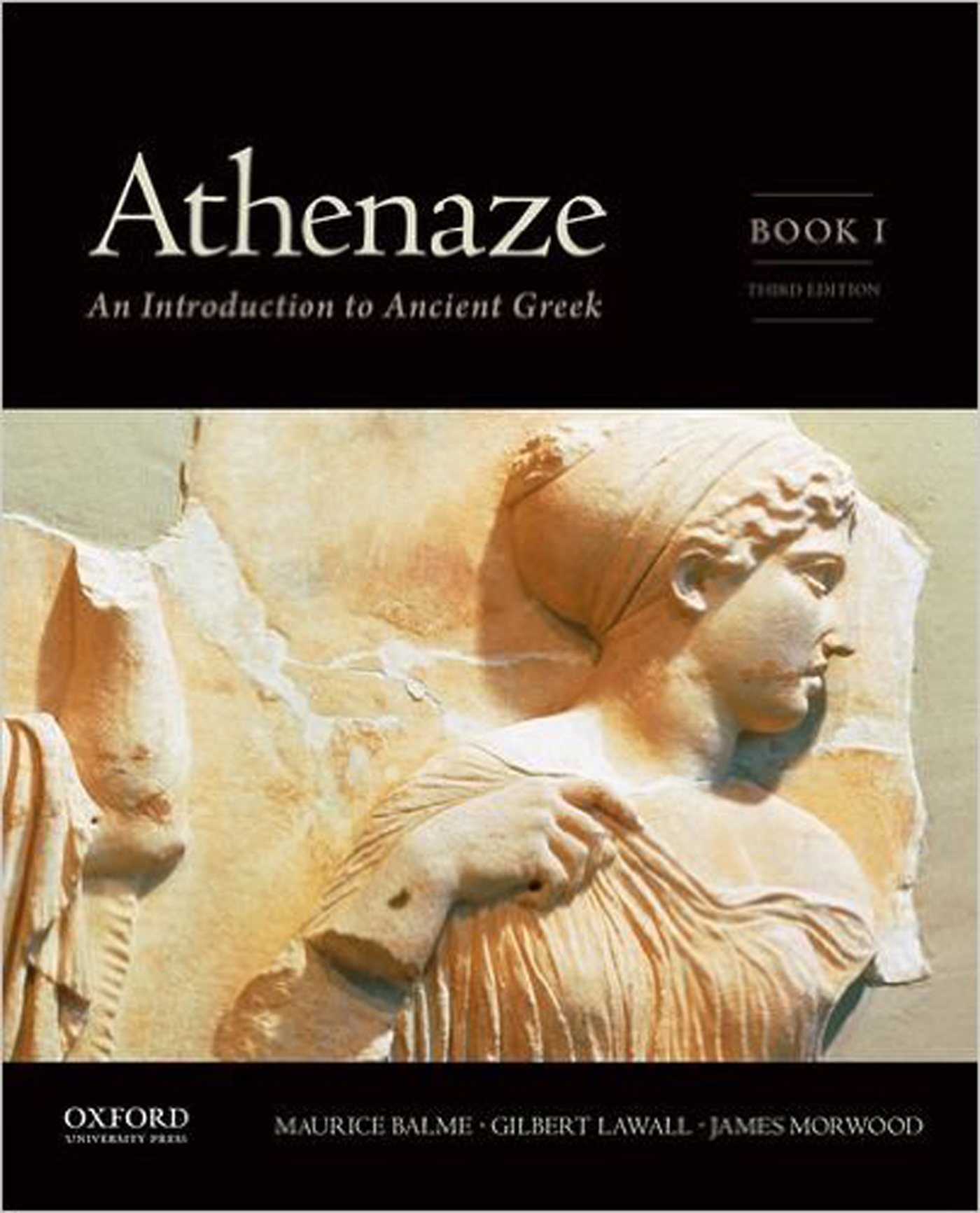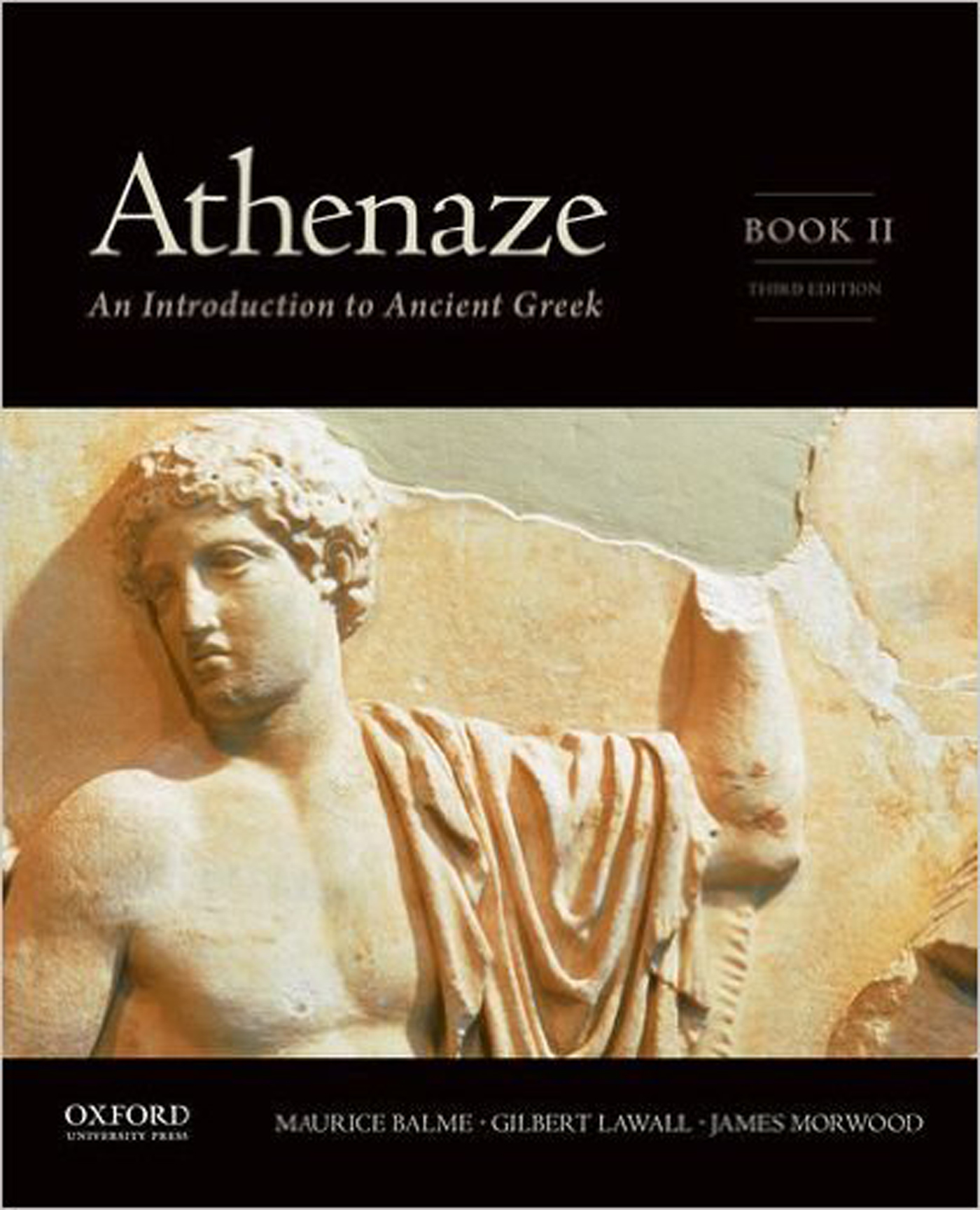When I first began teaching Greek almost twenty years ago, it was with the earlier incarnation of this book. When Greek to GCSE came out shortly after the start of the new millennium, like many schools we switched, and so it was a blast from the past to review these books here.

Figure 1. | Athenaze I.

Figure 2. | Athenaze II.
A lot of time and thought has gone into this new edition. I remember some of my former students really enjoying the stories, and so it was a joy to be reacquainted with Dicaeopolis, Myrrhine, Philip, Melissa and the family pet, Argus. The stories across both books largely focus upon this family, but there are other sections which tackle mythology, stories from Herodotus and the Peloponnesian War. Alongside these stories, right from the start of Book I, excerpts of Classical Greek literature are juxtaposed with New Testament Greek, exposing students to works from the Classical period and beyond. I also enjoyed the quirky section of Greek Wisdom to be found in every chapter. I could envisage this being used in a classroom as a sort of ‘Thought for the Day’.
The quality of the illustrations is excellent and the photographs are super. Old favourites such as the shepherd carrying a lamb are to be found alongside Leonidas from the film 300 and Brad Pitt as Achilles. There is a very helpful map of Greece at the start of Book I, and the beautiful and varied colour plates in the centre of both books are a welcome addition. The diver and the sphinx is a particular favourite.
The grammatical explanations are very thorough and very clear. The explanations do not rely on an existing knowledge of Latin, but students would need to know terms such as ‘transitive’ and ‘intransitive’. Epsilon contract verbs are introduced in the very first grammar note, which does demystify contracted forms, but may be a little overwhelming for an absolute beginner. The order in which tenses are introduced is a little more unusual: I am unsure why the 2nd aorist comes first before the 1st aorist and subsequently the imperfect tense, but perhaps that is because I am more familiar with Greek to GCSE and Reading Greek which does this differently. Similarly, there is some non-GCSE grammar in Book I (e.g. omicron contract verbs) and in Book II (mi verbs) which may hinder those students following the course under time pressure, and those with public examinations on the horizon.
The book is designed to be used by students on both sides of the Atlantic. This is evident from the US case order to be found routinely through both books. However, there is a helpful suggestion at the start for those of us on these shores. The reference section at the back of the books has UK case order, and UK students are advised to photocopy this and lay it over the relevant grammar as it appears in the book. I do wonder whether this would prove too tricky a task for some of my (dyspraxic) teenage students.
There is a very useful section on how to write Greek letters at the very beginning of Book I. This is all too often overlooked in the other Greek courses which I have encountered, and absolute beginners will find this particularly helpful. Conversely, the background sections at the end of each chapter show that these books go much further than just teaching Greek language.
New vocabulary is introduced before a story, and this can aid translation greatly when learning a language at speed. I also like the way that it is arranged according to part of speech, something which my own students prefer. Running vocabularies are provided, using bold type, but I found the layout of these a little confusing at times.
There is a variety of word-study and word-building exercises to enhance learning, and some exercises involving pairs of sentences for translation are very useful for teaching Greek-English. I liked the manipulation exercises which seem to fit well with the new GCSE demands. In the centre of Book I there is an excellent ‘review of verb forms’ and ‘preview of verb forms’ which lend themselves naturally to a flipped classroom task. Likewise, Book I concludes with blank verb charts to be photocopied and completed, and Book II opens with these verb charts in a very readable font size.
There is a lot of material in Book II which would be particularly appropriate for A Level students. Grammatical explanations are comprehensive, although occasionally there are inconsistencies in the lay-out of verbs. For example, subjunctive forms are given horizontally rather than vertically, no doubt to save space. There is a superb Aristophanes section at the end of Book II, allowing students to read passages of an original author confidently, with appropriate assistance.
As I made my way through both books, I gradually realised that these books make a course designed to enable students to learn Greek, and that they are not aimed at a particular specification or syllabus. With that in mind, I wonder whether they may serve as an alternative to Reading Greek or for use with older students (perhaps Sixth Formers or beyond). They would certainly be very useful for teachers to dip into for excellent grammatical explanations.
Would I buy the book for my own school students? We shall certainly be acquiring some, if just for reference. The books are quite pricey at £29.99 and they are quite bendy. Would they withstand the day-to-day wear-and-tear of a teenage schoolbag, I wonder? However, for older learners they would certainly provide a comprehensive and attractive route for learning Greek.
Although little in size – A5 being rather minute in comparison to most modern textbooks – the Little Greek Reader is vast in its scope and value. The humility of the title indicates that the intentions of the authors were not to create a glossy new course book for Greek teaching, but a collection of texts to supplement intermediate Greek language courses and to encourage the reading of a wider range of classical texts. They certainly do this with success.

Figure 3. | A Little Greek Reader.
A Little Greek Reader looks at a wide variety of grammatical topics through reading. Each chapter provides a simple introduction to a grammar topic and then a range of passages which contain useful examples. The grammatical introductions are not designed to replace traditional textbooks and are best only for a more experienced student. At times, the reader is left wanting a little more clarity and a few simple introductory examples.
Each passage is supplemented with an introduction and notes not only on linguistic but also cultural points, which stop the texts from becoming purely grammatical exercises and enliven them for readers new to the author or text in question. It is this focus on reading for pleasure that makes what at first sounds like a rather tedious chapter on particles into an enjoyable trip to the trial of Socrates and the plains of Troy. The range of authors and genres, both vast and exciting, adds to this: common A Level and undergraduate authors are joined by Callimachus, Arrian, New Testament Greek and an anonymous graffito from Mount Hymettus. The Greek font used is very clear and pleasing to the eye. However, the small size of the book leaves little space for notes and sometimes forces the prose passages into a narrow space, which makes it look confusingly like verse.
The excerpts of original text, which range in length from single words to passages of up to 20 lines, are not ordered according to their complexity; however, the grammar topics do start simply and increase in complexity, starting with indicative tenses and ending at impersonal verbs and verbal adjectives. This means that a good level of Greek is needed even to start at Chapter 1, despite the deceptively simple title ‘The Indicative Tenses of the Verb’. A review of indicative tenses is not necessarily best left to Herodotus or Euripides, as shown when the second passage introduces an infinitive being used as an imperative. Thus, the book is best for experienced students and perhaps most successful as a resource for teachers and lecturers to dip into to supplement their courses. However, variations in complexity mean passages will need to be chosen with care. Many passages would be appropriate for A Level teachers who wish to exemplify grammar points; others would challenge the best undergraduates.
At the back of the book there are chapters of additional reading passages in both prose and verse to encourage further reading. The appendices provide a guide to the grammar of Homer, Herodotus and New Testament Greek, an introduction to the scansion of hexameter and iambic trimeter, a list of literary terms, 23 short descriptions of Greek authors, a map of the Greek world and a complete word list. This is a very useful collection of notes for those new to reading original Greek; they help to contextualise the passages and explain some of the linguistic differences between dialects. The word list is particularly helpful in that it does not burden the user with meanings beyond those necessary and includes some irregular verb forms as their own entry in the alphabetical list.
A Little Greek Reader will no doubt be a very useful supplement for A Level or intermediate university courses in Ancient Greek. It is a real pleasure to read through such a broad range of texts and be reminded of the joys of Greek literature that await those who study the language.


